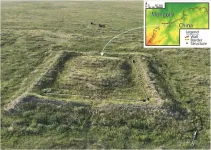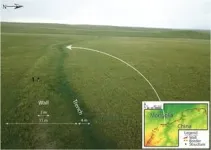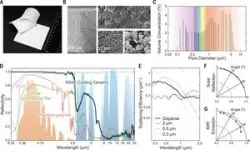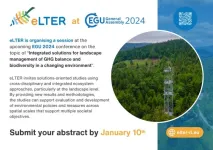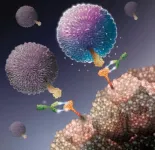(Press-News.org) New study sheds light on the previously overlooked Mongolian Arc—a monumental wall system in eastern Mongolia spanning 405 kilometers. This discovery not only reveals the significance of this ancient architectural marvel but also prompts crucial questions about the motives, functionality, and broader implications of such colossal constructions. Their findings contribute to a larger multidisciplinary project exploring historical wall systems and their socio-political, economic, and environmental impacts, marking a pivotal milestone in understanding ancient civilizations and their enduring legacies.
[Jerusalem, Israel] Prof. Gideon Shelach-Lavi from Hebrew University and Prof. Amartuvshin Chunag from the National University of Mongolia, and their team unveil a new discovery in their latest research published in the Journal of Field Archaeology. Their paper, "Unraveling the Mongolian Arc: a Field Survey and Spatial Investigation of a Previously Unexplored Wall System in Eastern Mongolia," sheds light on a monumental wall system that has remained largely overlooked in existing academic discourse.
The "Mongolian Arc," spanning 405 kilometers in eastern Mongolia, comprises an earthen wall, a trench, and 34 accompanying structures. Constructed between the 11th and 13th centuries a.d., this intricate system has emerged as a pivotal yet understudied facet of historical architectural marvels.
The research, conducted through a collaborative effort, involved a comprehensive approach combining remote sensing data collection, archaeological field surveys, and analysis through geographic information systems (GIS). Professors Shelach-Lavi and Amartuvshin's team also delved into ancient written sources to offer a preliminary interpretation of the design and potential functions of the Mongolian Arc.
"Understanding the significance of the Mongolian Arc unlocks profound insights into medieval wall systems, raising pertinent questions about the motives, functionality, and enduring consequences of such colossal constructions," remarked Prof. Gideon Shelach-Lavi.
This study is part of a larger multidisciplinary project, funded by a generous research fund from the European Research Council (ERC) addressing the construction of extensive walls and structures in northern China and eastern Mongolia during the 11th–13th centuries a.d. The findings not only contribute to unraveling historical mysteries but also offer a framework for exploring the broader socio-political, economic, and environmental impacts of such endeavors.
The published paper marks a pivotal milestone in the ongoing investigation, sparking renewed interest and further inquiry into ancient architectural wonders and their societal implications.
END
Unraveling the mysteries of the Mongolian Arc: exploring a monumental 405-kilometer wall system in Eastern Mongolia
2024-01-03
ELSE PRESS RELEASES FROM THIS DATE:
Call for EGU24 General Assembly Abstracts
2024-01-03
The General Assembly 2024 of the European Geosciences Union (EGU) will be held at the Austria Center Vienna (ACV) in Vienna, Austria and online, from 14–19 April 2024. eLTER will organise the following session:
BG8.14: Integrated solutions for landscape management of GHG balance and biodiversity in a changing environment
Convener: Syed Ashraful Alam, Katri Rankinen, Thomas Dirnböck, Harry Vereecken, Olga Vindušková
The session is co-sponsored by eLTER.
The abstract submission deadline is Wednesday, 10 January 2024, 13:00 CET.
Society is placing increasing and potentially competing demands on our environment. ...
Unlocking sustainable water treatment: the potential of piezoelectric-activated persulfate
2024-01-03
As cities grow bigger and faster, water pollution is becoming a serious problem. We need good ways to clean the water. Traditional cleaning methods, Persulfate (PS)- Advanced Oxidation Processes (AOPs), are good at treating the bad stuff in the water, but they require a lot of energy and chemicals, like special light and metals ions. This is costly and environmentally harmful. It's urgent to find better and more eco-friendly ways to clean it.
In a recent study published in Volume 18 of the journal Environmental Science and Ecotechnology, scientists ...
On-demand conformation of an artificial cytoskeleton
2024-01-03
Peptide nanotubes are tubular-shaped structures formed by the controlled stacking of cyclic peptide components. These hollow biomaterials show inner and outer faces, allowing the control over their properties.
Led by Juan R. Granja, researchers from the Center for Research in Biological Chemistry and Molecular Materials (CiQUS) presented a novel kind of cyclic peptide that, when light-irradiated, induces the formation or desegregation of nanotubes on demand. At the appropriate wavelength, the peptide switches from a folded to a flat conformation. When the planar conformation is ...
Can artificial intelligence (AI) improve musculoskeletal imaging?
2024-01-03
(Boston)—While musculoskeletal imaging volumes are increasing, there is a relative shortage of subspecialized musculoskeletal radiologists to interpret the studies. Is AI the solution?
“With the ongoing trend of increased imaging rates and decreased acquisition times, a variety of AI tools can support musculoskeletal radiologists by providing more optimized and efficient workflows,” says corresponding author Ali Guermazi, MD, PhD, chief of radiology at VA Boston Healthcare System and professor of radiology and medicine at Boston University Chobanian & Avedisian School of Medicine.
In a new article in the journal Radiology, BU researchers provide ...
Case Western Reserve researchers land $1.125 million National Science Foundation grant to advance safer, faster and less expensive medical-imaging technology
2024-01-03
CLEVELAND—Diagnosing cancer today involves using chemical “contrast agents” to improve the accuracy of medical imaging processes such as X-rays as well as computed tomography (CT) and magnetic resonance imaging (MRI) scans.
But those agents can be expensive, take more time to use and pose potential health concerns.
With a new four-year, $1.125 million grant from the National Science Foundation (NSF), researchers at Case Western Reserve University hope to develop an artificial intelligence (AI) alternative ...
PTSD: the brain basis of susceptibility - a free webinar from the Brain & Behavior Research Foundation
2024-01-03
The Brain & Behavior Research Foundation (BBRF) is hosting a free webinar, “PTSD: The Brain Basis of Susceptibility” on Tuesday, January 9, 2024, at 2:00 pm ET. The presenter will be Nathaniel G. Harnett, Ph.D., Director of the NATE Lab at McLean Hospital and Assistant Professor in Psychiatry at Harvard Medical School. Dr. Harnett is also the recipient of a 2021 Young Investigator Grant. The webinar will be hosted by Jeffrey Borenstein, M.D., President & CEO of the Brain & Behavior Research Foundation, and host of the public television series Healthy Minds.
Register today ...
Knowing how clinicians make real-world decisions about drug-drug interactions can improve patient safety
2024-01-03
INDIANAPOLIS — Drug-drug interactions causing adverse effects are common and can cause significant patient harm and even death. A new study is one of the first to examine how clinicians become aware of and process information about potential interactions and subsequently make their real-world decisions about prescribing. Based on these findings, the research team makes specific recommendations to aid clinician decision-making to improve patient safety.
“Drug-drug interactions are very common, more common than a lot of people outside the healthcare system expect. In the U.S., these interactions lead to hundreds of thousands of hospitalizations ...
Immune cell helps predict skin cancer patients’ chances of responding to treatment
2024-01-03
A type of immune cell can help predict which patients may benefit most from cancer immunotherapies, researchers from King’s College London, Guy’s and St Thomas’ Hospital Trust, and the Francis Crick Institute have found.
The study, published today in Nature Cancer, found that a rare type of T cells (a type of immune cell), can help predict the likelihood of whether a patient with advanced skin cancer will be responsive to immunotherapy treatments. The results could also lead to the development of new and more effective treatments for patients with melanoma who do not benefit from current ...
Reprogrammed fat cells support tumor growth
2024-01-03
Mutations of the tumor suppressor p53 not only have a growth-promoting effect on the cancer cells themselves, but also influence the cells in the tumor's microenvironment. Scientists at the German Cancer Research Center (DKFZ) and the Weizmann Institute in Israel have now shown that p53-mutated mouse breast cancer cells reprogram fat cells. The manipulated fat cells create an inflammatory microenvironment, impairing the immune response against the tumor and thus promoting cancer growth.
No other gene is mutated as frequently in human tumors as the gene for the tumor suppressor p53. In around 30 percent of all cases of breast cancer, the cancer cells show mutations or losses ...
Early primates likely lived in pairs
2024-01-03
Primates – and this includes humans – are thought of as highly social animals. Many species of monkeys and apes live in groups. Lemurs and other Strepsirrhines, often colloquially referred to as “wet-nosed” primates, in contrast, have long been believed to be solitary creatures, and it has often been suggested that other forms of social organization evolved later. Previous studies have therefore attempted to explain how and when pair-living evolved in primates.
More recent research, however, indicates that many nocturnal Strepsirrhines, which are more challenging to investigate, are not in fact solitary but live in pairs of males and females. But ...
